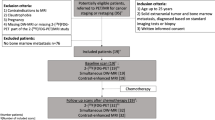Abstract
Background: MRI is an effective tool in evaluating bone marrow metastases. However, no study has defined which MRI sequences or image characteristics best correlate with bone-marrow metastases in neuroblastoma. Objective: To identify and refine MRI criteria and sequence selection for the diagnosis of bone-marrow metastases in children with neuroblastoma. Materials and methods: Ninety-one children (mean age: 3.2 years; standard deviation: 2.8 years) enrolled in the RDOG IV study participated in our study. Forty-five children had bone metastases determined by bone-marrow aspiration or biopsy (n=4), radionuclide imaging (n=2), or both (n=39). Spine lesions were characterized using coronal T1-weighted (T1W) sagittal short tau inversion recovery (STIR) and coronal gadolinium-enhanced T1-weighted (GAD) MR sequences. Contingency table analysis was performed to determine which MRI sequences and characteristics were associated with metastases. The MRI criteria for metastatic disease were then developed for each imaging sequence. The sensitivity, specificity, predictive values, and accuracy of these criteria were determined for the whole group, children younger than 12 months old, and children 12 months and older. Results: The MR characteristics that had significant (P ≤ 0.05) associations with metastases were homogeneous low T1-signal intensity, homogeneous high STIR-signal intensity, and heterogeneous pattern on T1, STIR, or GAD. Homogeneous low T1-signal had the highest sensitivity (88%), but a specificity of 62% for detecting metastases. A heterogeneous pattern on GAD was highly specific (97%), but relatively insensitive (65%) for detecting metastases. These MR characteristics were most accurate in children 12 months and older. Conclusion: The combination of non-contrast-enhanced T1W and GAD sequences can be used to determine the presence of spinal metastases in children with neuroblastoma, particularly those children who are 1 year and older.



Similar content being viewed by others
References
Brodeur GM, Seeger RC, Barrett A, et al (1988) International criteria for diagnosis, staging, and response to treatment in patients with neuroblastoma. J Clin Oncol 6:1874–1881
Kushner B, Cheung NK (1993) Neuroblastoma: an overview. Hematol Oncol Ann 1:189–201
Evans AE, D’Angio GJ, Propert K, et al (1987) Prognostic factors in neuroblastoma. Cancer 59:1853–1859
Brodeur GM, Pritchard J, Berthold F, et al (1993) Revisions of the international criteria for neuroblastoma diagnosis, staging, and response to treatment. J Clin Oncol 11:1466–1477
Kiely EM (1994) The surgical challenge of neuroblastoma. J Pediatr Surg 29:128–133
Dietrich R, Kangarloo H, Lenarsky C, et al (1987) Neuroblastoma: the role of MR imaging. AJR 148:937–942
Fletcher BD, Kopiwoda SY, Strandjord SE, et al (1985) Abdominal neuroblastoma: magnetic resonance imaging and tissue characterization. Radiology 155:699–703
Gilday DL, Ash JM, Reilly BJ (1977) Radionuclide skeletal survey for pediatric neoplasms. Radiology 123:399–406
Kornreich L, Horev G, Kaplinsky C, et al (1991) Neuroblastoma: evaluation with contrast-enhanced MR imaging. Pediatr Radiol 21:566–569
Mills AE, Bird AR (1986) Bone marrow changes in neuroblastoma. Pediatr Pathol 5:225–234
Ng YY, Kingston JE (1993) The role of radiology in the staging of neuroblastoma. Clin Radiol 47:226–235
Ruzal-Shapiro C, Berdon WE, Cohen MD, et al (1991) MR imaging of diffuse bone marrow replacement in pediatric patients with cancer. Radiology 181:587–589
Shulkin BL, Shapiro B, Hutchinson RJ (1992) Iodine-131-metaiodobenzylguanidine and bone scintigraphy for the detection of neuroblastoma. J Nucl Med 33:1735–1740
Siegel MJ, Jamroz GA, Glazer HS, et al (1986) MR imaging of intraspinal extension of neuroblastoma. J Comput Assist Tomogr 10:593–595
Couanet D, Geoffray A (1988) Magnetic resonance imaging for bone marrow metasases of neuroblastoma (in French). Bull Cancer 75:91–96
Tanabe M, Takahashi H, Ohnuma N, et al (1993) Evaluation of bone marrow metastasis of neuroblastoma and changes after chemotherapy by MRI. Med Pediatr Oncol 21:54–59
Lebtahi N, Gudinchet F, Nenadov-Beck M, et al (1997) Evaluating bone marrow metastases of neuroblastoma with iodine-123-MIBG scintigraphy and MRI. J Nucl Med 38:1389–1392
Siegel MJ, Ishwaran H, Fletcher BD, et al (2002) Staging of neuroblastoma at imaging: report of the radiology diagnostic oncology group. Radiology 223:168–175
Sofka CM, Semelka RC, Kelekis NL, et al (1999) Magnetic resonance imaging of neuroblastoma using current techniques. Magn Reson Imaging 17:193–198
Volger JB III, Murphy WA (1988) Bone marrow imaging. Radiology 168:679–693
Brossard J, Bernstein ML, Lemieux B (1996) Neuroblastoma: an enigmatic disease. Br Med Bull 52:787–801
Kanegawa K, Nishiyama S, Koshino T, et al (1996) MR imaging in patients with bone marrow metastases of neuroblastoma (in Japanese). Nippon Igaku Hoshasen Gakkai Zasshi 56:368–372
Couanet D, Geoffray A, Hartmann O, et al (1988) Bone marrow metastases in children’s neuroblastoma studied by magnetic resonance imaging. Prog Clin Biol Res 271:547–555
Pfluger T, Schmied C, Porn U, et al (2003) Integrated imaging using MRI and 123 I metaiodobenzylguanidine scintigraphy to improve sensitivity and specificity in the diagnosis of pediatric neuroblastoma. AJR 181:1115–1124
Acknowledgements
Supported in part by Cancer Center Support (CORE) Grant CA 21765 and the Radiology Diagnostic Oncology Group (RDOG [IV] 6880) from the National Cancer Institute and by the American Lebanese Syrian Associated Charities (ALSAC).
Author information
Authors and Affiliations
Corresponding author
Rights and permissions
About this article
Cite this article
Meyer, J.S., Siegel, M.J., Farooqui, S.O. et al. Which MRI sequence of the spine best reveals bone-marrow metastases of neuroblastoma?. Pediatr Radiol 35, 778–785 (2005). https://doi.org/10.1007/s00247-005-1470-2
Received:
Revised:
Accepted:
Published:
Issue Date:
DOI: https://doi.org/10.1007/s00247-005-1470-2




